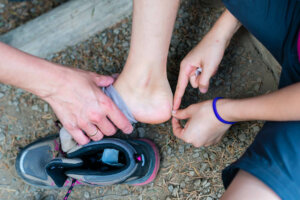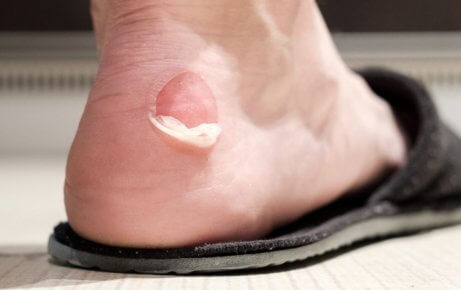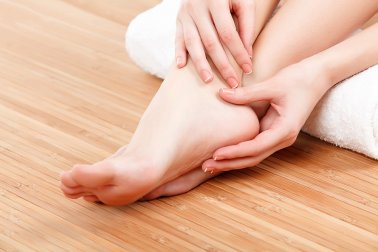Should You Pop Blisters?

A blister is a raised and palpable skin lesion which forms in the epidermis and is filled with fluid. In other words, blisters are kind of fluid-filled sacks. It can also be called a vesicle when it’s smaller. Blisters are very common, as they can be caused by numerous factors such as chafing. In this article we’ll briefly explain what they are. We’ll also explain if you should or shouldn’t pop blisters.
Why do blisters form?
A blister is formed by a change in the epidermis. This can be caused by rubbing, heat, or skin diseases. They often form when there’s friction, for example, when your shoes don’t fit well and rub part of your foot. Other causes include:
- Burns
- Freezing
- Eczema
- Allergic reactions
- Autoimmune diseases like pemphigus
- Epidermolysis bullosa
- Infections like chickenpox zoster and herpes simplex
- Skin infections including impetigo
You might be interested in: How to Treat Burns in Children
Symptoms

Blisters cause pain and the skin becomes red and irritated. Also, if they break, you can experience complications like infections. When this happens, they often produce pus, and the surrounding area becomes hot and very painful. It can even cause a fever. In fact, shoes are the most common cause of blisters, they usually cause discomfort when walking.
Should you pop blisters?
Typically, blisters will heal on their own. You don’t have to use any medicines. Generally, the liquid is reabsorbed and the skin on the blister dries. It’s important to avoid popping blisters in order to reduce the risk of infection.
So, in general, you shouldn’t pop blisters. As we’ve said, this increases the risk of infection and complicates healing. However, you could do it with sterile material and proper care afterward. Either way, the best thing is to cover it with a patch or bandage.
If there’s pus or it seems infected, it’s best to consult a doctor. In some cases, you’ll have to have the blister surgically removed.
Procedure to drain blisters
The environment should be as clean as possible. You should wash the area around the blister with soap and water, and disinfect it with alcohol or hydrogen peroxide. In addition, you have to use a sterile needle. To make a sterile needle, leave it in alcohol for a few minutes or heat it with a lighter flame.
You should only pop the blister once and on one side. Ideally you should press it with sterile gauze to empty the pus. Then put antiseptic on it and then some sterile gauze. You shouldn’t rip off leftover skin. Due to the complexity of this procedure, you should only do it when the blister is too large or painful.
You might be interested in: 5 Tips to Prevent Your New Shoes from Hurting You
How to prevent blisters

Since chafing causes most blisters, there are some very useful prevention measures:
- Wear comfortable shoes that fit well. Ideally, tie your shoes tightly. That way, you’ll reduce the movement between your foot and the shoe.
- Always wear socks. In addition, it’s important that they also fit properly. If you use nylon socks, you can reduce your foot’s humidity. Similarly, you should throw away any worn out socks.
- Protective patches are useful if you’re going on a hike.
- If the blister is on your hand due to manual labor or sports, you should wear gloves.
In conclusion
It’s normal if your first reaction to a blister is to want to pop it. The continuous rubbing and the blisters themselves are very annoying. However, it’s best to let it heal on its own. The covering skin protects against infection. In addition, the liquid it contains stimulates healing in the area.
The most effective way to help them heal is to keep the area clean and disinfected. Washing it with warm soapy water is enough.
All cited sources were thoroughly reviewed by our team to ensure their quality, reliability, currency, and validity. The bibliography of this article was considered reliable and of academic or scientific accuracy.
- Ampollas. (n.d.). Retrieved from https://medlineplus.gov/spanish/blisters.html
- El mejor tratamiento para las ampollas | Compeed®. (n.d.). Retrieved April 13, 2019, from https://www.compeed.es/como-tratar-una-ampolla/
- Qué hacer en caso de tener una ampolla – Primeros auxilios. (n.d.). Retrieved April 13, 2019, from https://www.webconsultas.com/primeros-auxilios/ampollas/que-hacer-en-caso-de-tener-una-ampolla
- Ampollas. (n.d.). Retrieved April 13, 2019, from https://www.sanitas.es/sanitas/seguros/es/particulares/biblioteca-de-salud/Lesiones/cutaneas/ampollas.html
This text is provided for informational purposes only and does not replace consultation with a professional. If in doubt, consult your specialist.








